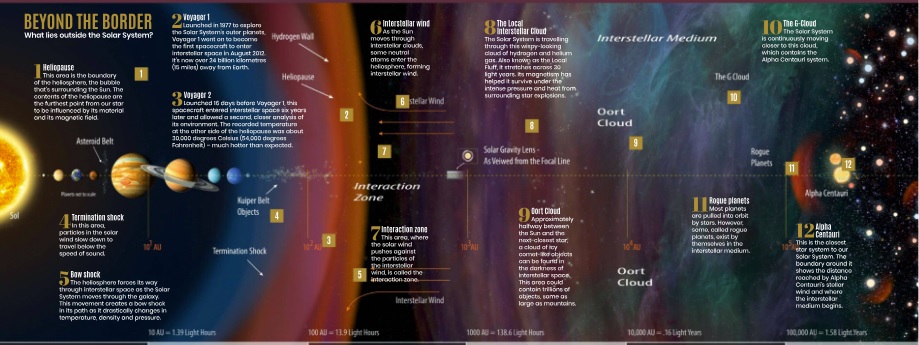Denemek ALTIN - Özgür
THE FINAL FRONTIER
All About Space UK
|Issue 161
Beyond the reach of the Sun is a fascinating region of the cosmos that were only just beginning to explore

The importance of the Sun to our little region of space is immeasurable, providing the light and energy that made life on Earth possible billions of years ago and that continue to sustain us today. However, our star's influence only extends so far. Beyond the reach of the Sun is a region of the cosmos called interstellar space. Though the first impression of this region may be a cold, empty stretch of space, the truth is that interstellar space is fascinating, exciting and not totally empty.
In many ways, interstellar space represents the 'final frontier' for space exploration, the dream of humanity extending its reach further than its own star and beyond its home planetary system. The distance to interstellar space and the distance to the next star is also a stunning example of how vast the cosmos truly is, highlighting humanity's small place within it. And yet, our species, on a ball of mud and rock around a very average star, has already tested the waters of interstellar space with two active spacecraft.
Launched in 1977, the NASA spacecraft Voyager 1 and 2 left the Solar System in 2012 and 2018 respectively. Since then, the two missions have been collecting data from beyond the influence of the Sun. Voyager 1 is now the furthest human-built object from Earth at a whopping 24 billion kilometres (15 billion miles) away. That's over 161 times the distance between Earth and the Sun, which is around 150 million kilometres (93 million miles), which is the basis of a unit of measurement called an astronomical unit, or AU. That means at a distance of around 161 AU, it takes about 20 hours for a signal travelling at light speed to journey between NASA's Voyager team and the Voyager 1 spacecraft.

Bu hikaye All About Space UK dergisinin Issue 161 baskısından alınmıştır.
Binlerce özenle seçilmiş premium hikayeye ve 9.000'den fazla dergi ve gazeteye erişmek için Magzter GOLD'a abone olun.
Zaten abone misiniz? Oturum aç
All About Space UK'den DAHA FAZLA HİKAYE

All About Space UK
MYSTERIES OF THE UNI WHERE ARE ALL THE SPIRAL GALAXIES?
There are far fewer spiral galaxies than elliptical ones in the Supergalactic Plane, and scientists are keen to discover why
7 mins
Issue 161

All About Space UK
ZOMBIE STARS
+10 OTHER TERRIFYING SPACE OBJECTS
8 mins
Issue 161

All About Space UK
HOW TO BEAT LIGHT POLLUTION
Thought it was impossible to observe the wonders of the night sky from towns and cities? Think again. Follow our tips and tricks on successfully observing through sky glow
2 mins
Issue 161

All About Space UK
15 STUNNING STAR CLUSTERS
These beautiful stellar groupings are spattered across the cosmos
8 mins
Issue 161

All About Space UK
Eileen Collins "It was a difficult mission...we were the first to see Mir"
Having served as both the first female pilot and first female commander of NASA's Space Shuttle, Collins boosted the involvement of women in space exploration to a whole new level
9 mins
Issue 161

All About Space UK
MARS LEAKS FASTER WHEN IT'S CLOSER TO THE SUN
The Red Planet has lost enough water to space to form a global ocean hundreds of kilometres deep
2 mins
Issue 161

All About Space UK
FUTURE TECH KANKOH-MARU
This ambitious reusable spacecraft will be capable of taking 50 people to and from orbit
2 mins
Issue 161

All About Space UK
THE FINAL FRONTIER
Beyond the reach of the Sun is a fascinating region of the cosmos that were only just beginning to explore
8 mins
Issue 161

All About Space UK
A long-lost moon could explain Mars' weird shape and extreme terrain
A long-lost moon could explain why Mars is so different from the other rocky planets in the Solar System. Today Mars has two tiny moons.
2 mins
Issue 161

All About Space UK
A sprinkling of cosmic dust may have helped kick-start life on Earth
Cosmic dust may have helped kick-start life on Earth. New findings challenge a widely held assumption that this wasn't a plausible explanation.
3 mins
Issue 161
Listen
Translate
Change font size
